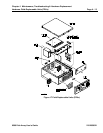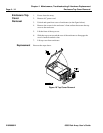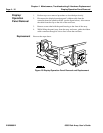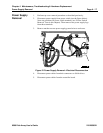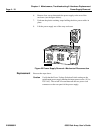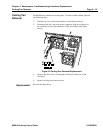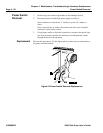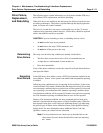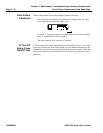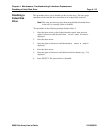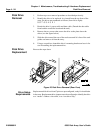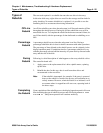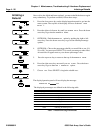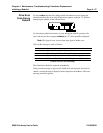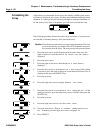
6500 Disk Array User’s Guide 21020690 B
Chapter 4 Maintenance, Troubleshooting & Hardware Replacement
Drive Failure, Replacement, and Rebuilding Page 4 - 21
Drive Failure,
Replacement,
and Rebuilding
The following pages contain information you will need to handle 6500 array
drive failures, drive replacement, and drive rebuilding.
When all 9 drives are installed in the subsystem, the failure of one drive does
not affect performance. The failure is reported through the display/operation
panel. An alarm will sound if enabled.
The loss of a second drive can cause a catastrophic loss of data. To ensure
continued array operation without data loss, a failed drive should be replaced
and its data rebuilt as quickly as possible.
CAUTION If you are formatting a drive or rebuilding data on a drive,
• do not reset the array by any method,
• do not remove the array's SCSI terminator, and
• do not turn off the power to the array.
Determining
Drive Failure
The array uses the following conditions to identify a failed drive:
• The drive does not pass drive tests or fails in command time-out.
• A single drive is unformatted or from another set.
• Drive error thresholds.
If any of the above conditions are met, the controller will spin-down the drive
and report the failure.
Reporting
Drive Failure
In the 6500 array, drive failures create a SCSI Unit Attention condition in the
array if the option is not enabled and unit attention reporting
is enabled.
Following is the conditional logic of reporting for drive failures. In the event
of a drive failure: if the alarm is enabled, then the alarm will sound; if recovered
error reporting is enabled, then a recovered error will be reported; if recovered
error reporting is not enabled but Unit Attention reporting is enabled, then a
Unit Attention condition will be reported; if neither recovered error reporting
nor Unit Attention reporting are enabled, then no error will be reported.
During a Unit Attention condition, the next command received from each
initiator is ignored and the array reports a Check Condition status. When the
host requests sense data, it will receive an Additional Sense Code indicating
the general type of failure and an Additional Sense Code Qualifier offering
further detail. For more information about Additional Sense Code and
Qualifier, contact your trained service technician.
Note If a second data drive has a fatal error as described above, the
subsystem will power-down the failed drive and start reporting
.



